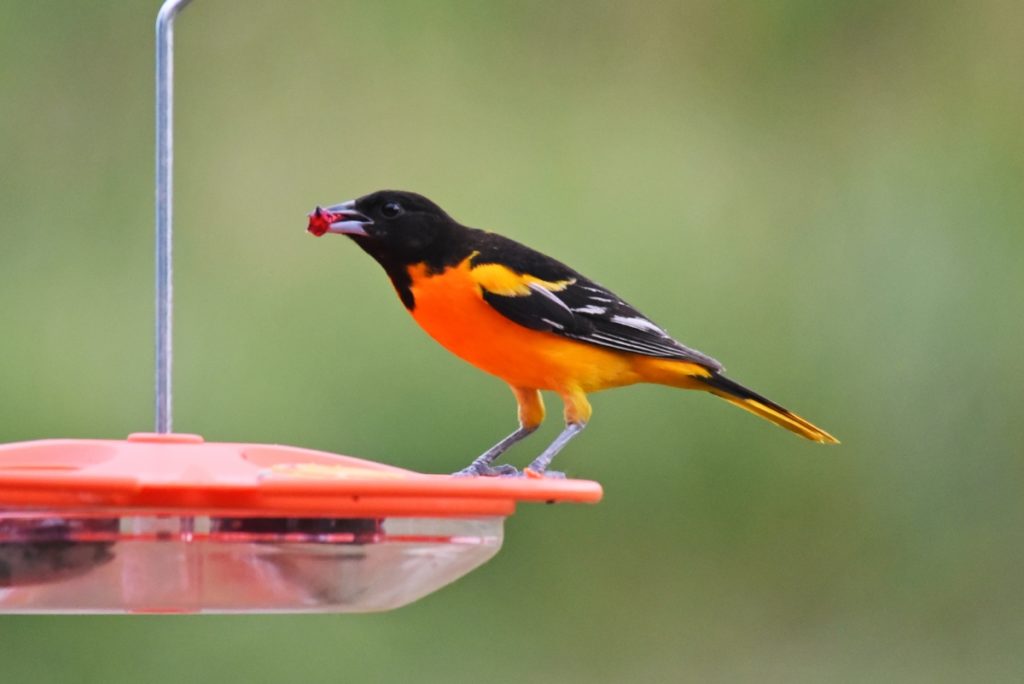Howdy, folks! I’m an Oriole. Here’s a little about me:
I am a bird of the Icteridae family and the genus Icterus, although we can also be called “blackbirds” (although that term is applied to many other birds). My species, Icterus galbula, is known as the Baltimore Oriole.
I was named Baltimore Oriole because my coloration reminded people of Lord Baltimore’s coat of arms (which had a black eagle on it). In fact, the state bird of Maryland is the Baltimore Oriole.
I enjoy eating fruit (especially oranges) and insects. If you would like to attract me to your home, try hanging some fruit from a string in your yard!
Icterus galbula, better known as the Baltimore oriole, is a brightly colored bird with orange around its body and black on its wings and head. Males have a bright orange belly, while females have a yellowish belly.
These birds can be found across the United States and up into Canada during their mating season. During the winter, they migrate to Mexico and Central America.
They build their nests near open areas, like parks and golf courses. While they usually like to hide their nests in trees, these birds are sometimes so brazen that they will build nests out in the open.
The Baltimore oriole mostly eats insects and nectar from flowers, although it will also eat fruit.
Hello! My name is Icterus galbula, but you can call me Baltimore Oriole. You can find me in the eastern United States, and southern Canada during the spring and summer. I like to hang out in trees, eating insects for breakfast, lunch, and dinner. Not only am I orange and black, but my nest is also shaped like a gourd! And when the time comes for me to fly south for the winter, I’ll just join my flock in the trees of Central America or northern South America. Now that you know where I live, maybe we’ll bump into each other someday!
Hi! My name is Baltimore Oriole, and I’m an icterine passerine bird.
I’m a member of the Icteridae family, and I’m native to eastern North America. You can find me in forests and backyards near you!
I’m 11 to 15 inches long, with a wingspan of 18 to 24 inches. I’m one of the larger members of my family.
My feathers are bright orange and black. You won’t be able to mistake me for any other bird!
I love insects. That’s what I eat! Mostly beetles, but also moths and caterpillars, wasps and bees—everyone loves me because I help keep pests under control. In the winter, I like to have seeds when there aren’t many bugs around.
Life’s tough for a Baltimore oriole. Take one look at them, and you’ll see why.
They’re just not built for stealth. I mean, if you need to hide from your predators, being orange and black is not the ideal way to go about it. But if you’re trying to attract a mate? Hey, maybe being orange and black isn’t such a bad thing after all.
Baltimore orioles are known as icterids, which is a family of birds that includes orioles, meadowlarks, oropendolas, and grackles. They’re also known as icterids because they tend to be black and yellow or black and orange—though not all of them are (they can also be black and white).
Baltimore orioles eat insects during the summer, but in the winter, their diets consist almost entirely of fruit.
We’re big fans of the Baltimore Oriole, and we hope you are too!
The Baltimore Oriole is a small species of bird that lives in North America. The males are bright orange with a black head and back, while the females are dull yellow with olive-colored wings and tail feathers. It takes its name from the coat of arms of the family of Lord Baltimore (the founder of Maryland), which was also orange and black.
They typically live in open woodlands near water, where they catch insects by flying out from a perch to snatch them midair, then returning to the perch to eat. They sometimes hover over a body of water while hunting for food. The birds travel south during the winter months and return north in early spring to breed.
